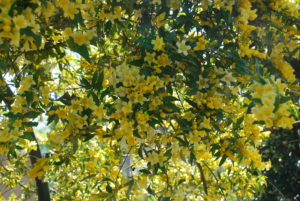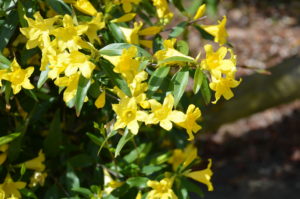Carolina jessamine (Gelsemium sempervirens) is one of the most beautiful native vines in the South (USDA Zones 6 to 9). In February and March, its bright yellow flowers are commonly seen growing along roadsides in the Southeastern U.S. It is frequently mistaken for forsythias a shrub that rarely blooms in winter.
Vines grow vigorously, 20 feet or more if not pruned. Gardeners may choose to rein a jessamine into a 3-4 foot tall shrubby vine covering only 3-5 square feet of ground. Its annual growth rate is 12-15 inches in average soil and no irrigation and a lot more aggressively in rich soil and adequate watering.
From February to April, sweetly scented golden yellow flowers blanket the cascading, fine textured foliage. The tubular 1 to 1½ inches long blooms are 5 lobed. Flowers invite early arriving butterflies and bumblebees into your garden. Glossy 1 to 3 inches long leaves are evergreen.
Carolina jessamine is easy to grow. Plant it on a trellis (arbor), in a container on a deck and patio or as a ground cover along steep banks erosion control.
Carolina jessamine tolerates either full to partial sunlight. Flowering is more prolific and foliage is denser in full sun. Moist well-drained soil is ideal. Jessamine can withstand periods of drought once established after one year. Ground cover plants should be spaced 3 feet and 5- 8 feet apart as a trellis.
Fertilize while the plant is actively growing with moderate amounts of a slow-release fertilizer such as Osmocote™ or Nutricote™. Do not over-fertilize as it may reduce flowering.
In containers jessamine may require pruning 2-3 times annually to hold growth in check. Many gardeners utilize a string pruner for this task. Old, sickly or out of control vines can be pruned back to a few feet above ground level after flowering. Remove all dead or broken branches.
Popular Cultivars:
‘Pride of Augusta’ – popular double-flowered cultivar with long bloom period; also listed as ‘Plena’.
‘Margarita’ – slightly larger flowers and is rated cold hardier than species.
‘Woodlander’s Pale Yellow’ – large creamy-yellow but is rated as not as cold hardy (Zone 8 -10).
Butterscotch™ – blooms 2 to 3 weeks later than species and often re-blooms in fall.
Lemon Drop™ – more compact with shrub-like habit and with light yellow flowers.
All parts of the plant are highly poisonous. The sap may cause skin irritation. Insects or diseases are rarely a problem on Carolina jessamine. Deer and rabbits will not eat it. Carolina jessamine is the state flower of South Carolina.



 Posted in
Posted in 
